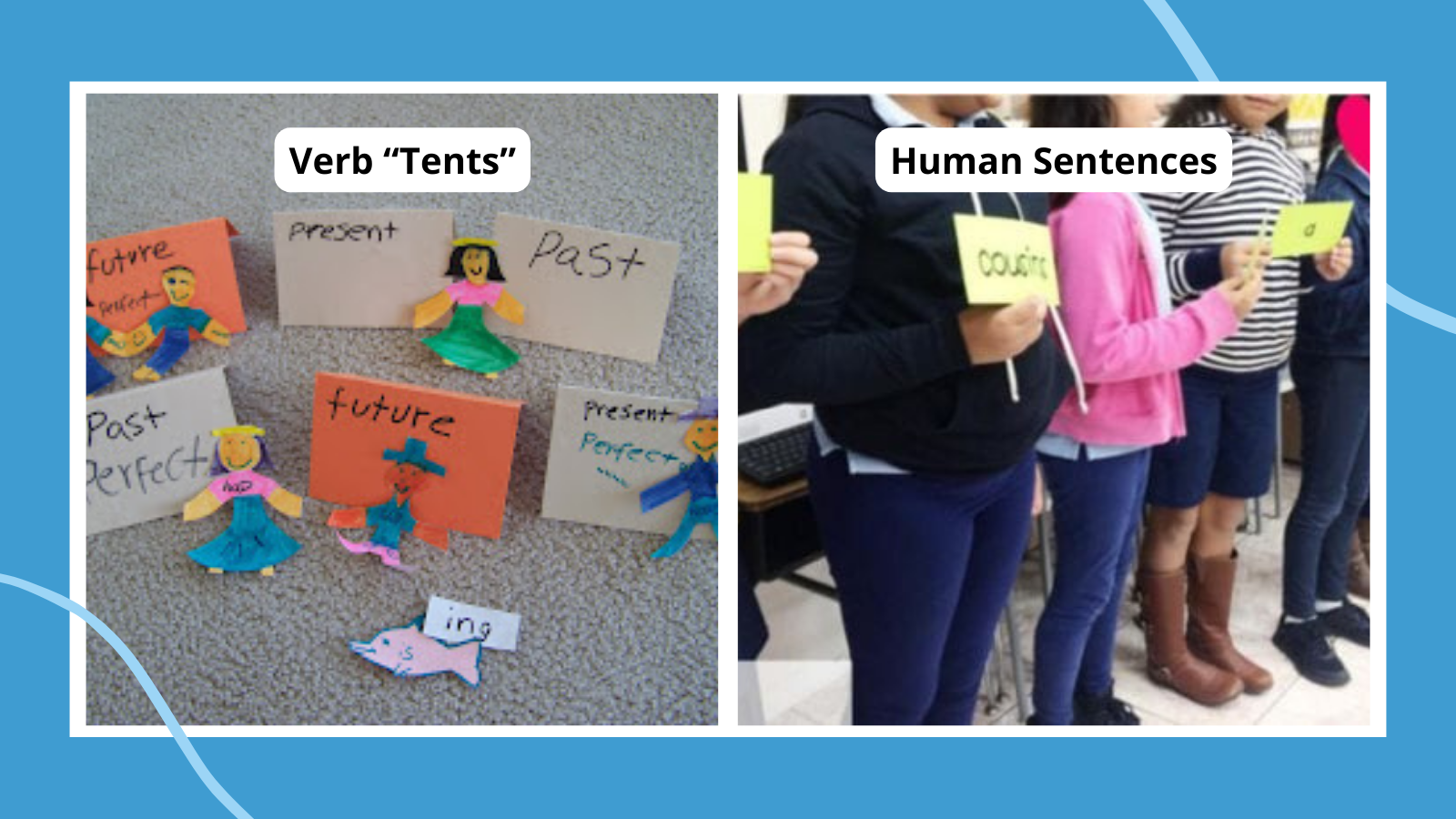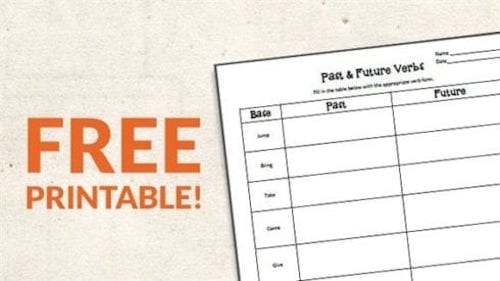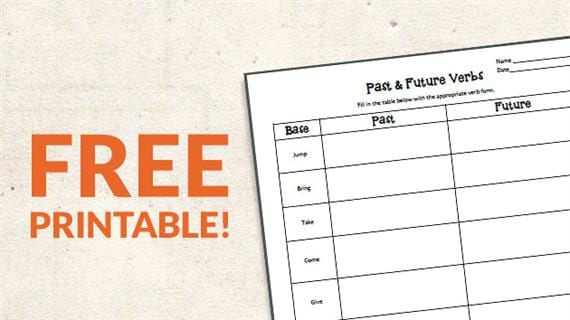Let’s face it, most of us don’t need to know which verb tense is “future continuous perfect.” But we do need to use verbs correctly so others understand our meaning. Most children pick up verb tenses as they learn to speak, but there is some advantage to understanding and being able to name specific tenses, especially when it comes to irregular verbs or learning a new language. Try these activities to help kids understand and use verbs correctly in everyday speech and writing.
Need a review of the 12 verb tenses in English? Check out this video for a quick explainer.
Jump to:
- Hands-On Ways to Learn Verb Tenses
- Reading and Writing Verb Tense Activities
- Creative Ways to Teach Verb Tense
Hands-On Ways to Learn Verb Tenses
1. Conjugate and Move
As you go from one place to another (out to recess, down the hall to lunch), have students pick different movements to complete. Use those in sentences for practice: “We are going to march. We are marching. We marched to the playground.”
2. Act it Out
Make a set of cards with various verbs written on them (or buy a ready-made set like this one). Then, make another set with the verb tenses you’d like kids to practice. Students come to the front of the room, draw two cards, then figure out a way to act them out so other students can guess both the verb and the tense.
3. Sticky Note Sort
Divide a piece of chart paper into columns for the tenses you’re working on. On sticky notes, write verbs conjugated into these different tenses. Pass out the sticky notes and ask students to place them in the correct place on the chart.
4. LEGO Verb Match
Use a marker and small piece of masking tape to write verbs and their corresponding conjugations on the sides of LEGO bricks. Kids match them up, building pairs or towers showing all the conjugations of a particular verb.
5. Time Travel
Post three paper “buttons” on your white board: past, present, and future. Call each student up to the “time machine” and ask them to choose a verb (or give them one from a list). As they slap each “button,” the whole class calls out the correct conjugation.
Get free printable: Regular Verb Tenses at Teachers Pay Teachers
6. Helping Verb Links
Teaching helping verbs? It might help kids to visualize them as links in a chain. Cut some paper strips and write sentence clauses on them. Staple these together as individual links, but don’t attach them yet. Kids need to figure out the missing helping verb, write it on a strip, and use it to link the sentence clauses together.
7. Sticky Note Endings
Here’s another way to use sticky notes: write a variety of tense endings on individual notes, such as “-ed,” “-ing” or “-s.” Write a list of infinitive verbs on the board, and have kids come up one by one to pick the correct ending and stick it in place. (Remind them they may need to make some spelling adjustments to the root words in some cases.)
8. Tap Light Tenses
We love using tap lights in the classroom! Label them with different tenses, then have students draw a verb card, tab the various lights, and conjugate the verb.
9. Verb Tense Bean Bag Toss
Label containers with different tenses, and write a list of infinitive verbs on the board. Players toss a beanbag, choose a verb from the board, and conjugate it. If they’re right, they add their answer to the board next to appropriate verb. Once all the tenses have been listed for a verb, kids can no longer choose it when its their turn.
Reading and Writing Verb Tense Activities
10. Right and Wrong
Sometimes it can be just as helpful to see and hear what’s incorrect as what’s correct. Ask students to come up with sentences that use verb conjugations incorrectly. Then, work together as a class to correct them.
11. Timelines
Verb tenses and timelines are a perfect match! Have kids make lists of things they’ve done in the past, things they’re doing right now, and things they’d like to do the future. Then, plot those actions and events on a personal timeline, using tenses correctly.
12. Verb Graphic Organizer
You can do these in a couple of different ways: use one page for each verb, writing the infinitive at the top and various conjugations on the rest of the page. (This is especially helpful for irregular verbs.) Or, create a graphic organizer for specific tense, using the page to record examples, tips, and examples.
13. Past, Present, and Future Stories
Use a picture prompt to write a story in past tense. Then change it to present and future tense by conjugating the verbs. Here are 150 picture prompts to get you started!
14. Roll and Write
Assign specific tenses to numbers on a die. Then, assign infinitive verbs to numbers on another die (use a polyhedral die to increase the options). Students roll the dice, record their verb and required tense, that write a sentence using it correctly.
15. Verb Tenses Continued Story
This is tricky, but a lot of fun! Use a die with tenses assigned, as you would for Roll and Write. The first student rolls the die and starts a story, using the tense indicated. Then they pass the die to the next player, who rolls and continues the story. It gets challenging to find ways to switch up the tenses, but you can wind up with some pretty hilarious results.
16. Tenses Highlight
Give students a reading passage and several colors of highlighters. As they read, have them highlight the different tenses in different colors. When they’re done, they can compare their results with a partner and see if they missed any.
17. Verb Webs
In the center of piece of paper, have students write any topic they like in a circle in the middle. This can be a movie they love, their favorite hobby, what they did over the summer, etc. Next, choose a tense to practice. Kids draw lines out from their center circle and add conjugated verbs into additional circles, using words that relate to their center circle. For example, if the topic in the center is “Winter” and the tense is “past continuous,” kids might write “was sledding,” “was skating,” and “was drinking cocoa.”
18. Song Lyric Analysis
Let students choose any song they like. Their task is to find a copy of the lyrics and note all of the different tenses used throughout.
19. News Article Rewrite
Choose a student-appropriate article from a news website and share it with your class. Their job is to rewrite the article, converting it to a different tense. For instance, if the article is written in past tense, they might instead convert it to future tense.
20. Would You Rather
Get some practice with modal verbs like “would” by writing or verbalizing responses to “Would You Rather” questions! We’ve got a huge list of kid-appropriate scenarios to try here.
21. Yesterday, Today, Tomorrow
Write a quick journal entry where kids describe something that happened yesterday, something that’s happening today, and something that’s going to happen tomorrow. This is a five minute writing exercise that makes an excellent bell ringer to start the day.
22. Reading Tense Tracker
Divide a sticky note (larger ones work better) into past, present, and future columns. As kids read a book, have them make tally marks in each column for the verbs they come across. This is great for raising awareness of how authors use tenses effectively.
23. Before During After
Here’s another way to use picture writing prompts. Show an image, and ask students to write what they think happened in the moments before the picture, what’s happening now, and what will happen next.
More Creative Ways to Teach Verb Tense
24. Verb Tents
Who doesn’t love a grammar pun? Fold notecards in half and write verb tenses on them, then set them up on a table so they look like little tents. Choose a small figurine and decide what action it should complete. Then, move the character to different tents, conjugating as you go.
25. Verb Rainbows
Cut a cloud out of white construction paper, and write an infinitive verb in the middle. Then, cut strips of colored paper and glue them into place across the bottom of the cloud to represent a rainbow. Write the various conjugations of the verb on the strips. Now you have colorful crafts that also teach verbs!
26. Verb Tenses Word Wall
Word Walls are an amazing tool in the classroom. Create one with a variety of tenses, posting the definition of each as your class learns it, and filling the space around it with conjugated verbs to match.
27. Verb Tense Arrows
Visual cues can really help many learners. Get in the habit of using arrows pointing backwards (usually to the left in English) for past tense, and arrows pointing forward (right) for future tenses. Kids can even point ahead and behind them to help them make kinesthetic connections.
28. Verb Tense Bingo
Use a bingo card generator to make cards with various tenses in the squares. Then, read out verbs in different conjugations. Kids find a matching square on their card and write the word in. When they get a full row, they call out Bingo! Check their answers, and award a small prize if you like.
29. Verb Tense Collage
You’ll need lots of old newspapers and magazines for this one, along with scissors and paste. In the middle of a big piece of paper, kids write the tense you’re working on. Then, they look through the old media materials and cut out examples of that tense in action, pasting them into their collage. Students can work on their own or in pairs or groups for this activity.
30. Verb Flashcards
They may not be exciting, but they’re a simple and effective way to practice. Make your own from notecards, with infinitive verbs on the front and conjugations on the back. Or, try a tool like Quizlet to make quick and easy digital flashcards instead.


